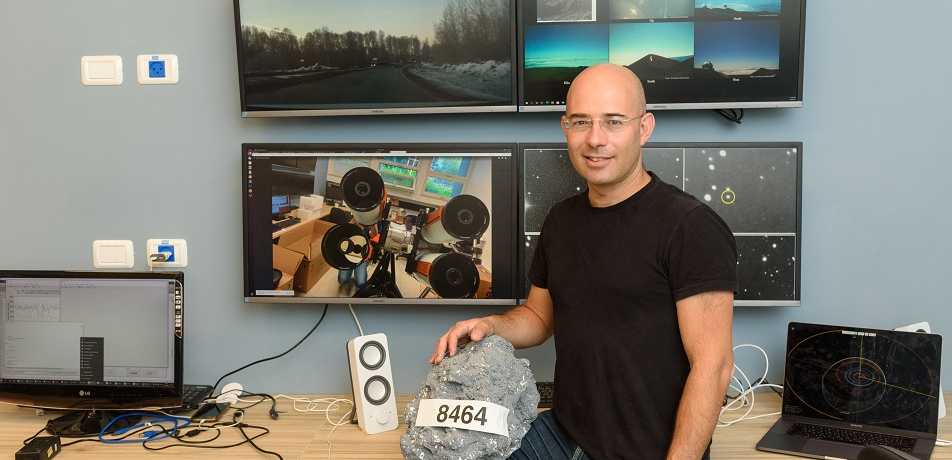Hooked on space
For Staff Scientist Dr. David Polishook, there’s always been something about space
Briefs

It’s hard not to get excited about space when talking to Dr. David Polishook, a staff scientist in the Department of Physics Core Facilities. His animated stories and passion for his work are contagious. His science journey began when he was just six years old. He recalls that his parents took the family to Cape Canaveral, Florida where he saw the Saturn 5 rockets, followed by a visit to the National Air and Space Museum in Washington, D.C.
I was shocked!” he remembers. “I was hooked on space.
It was then I knew I wanted to be an astronomer.”
After the army and a short stint in high-tech, David studied geophysics and planetary sciences at Tel Aviv University along with another love of his, history.
“Astronomy is a lot of numbers, but it is also history,” he says. “You are looking at things that happened in space many years ago because you want to know how it all began.”
David also earned his MSc and PhD at Tel Aviv University, studying asteroids in the Department of Geophysics and Planetary Sciences, and completed postdocs at the Weizmann Institute and MIT.
Like history and astronomy, asteroids present another duality—“Asteroids are planetary bodies in the Solar System, and in a sense you can hold these rocks from space in your hands, which makes them geophysical in nature,” David explains. “You can also observe them while they are in space, which places them in the world of astronomy.” And observe he has. Over the 20 years that he has been studying asteroids, David has discovered about 20 of these rocky celestial bodies, and even has one named after him— Polishook 8464.
Weizmann’s golden age of astronomy
In his role as head of the Observatory Unit of the Department of Physics Core
Facilities, David plays a central role in what he calls the Weizmann Institute’s “Golden Age of Astronomy.” In addition to the astronomical arsenal of tools and collaborations, which includes the Martin S. Kraar Observatory on the Weizmann campus, bservational time at the Magellan Telescope in Chile, and partnership in the development and construction of the next-generation Giant Magellan Telescope there, David is overseeing the process of opening a new scientific observatory—the second one in the history of Israel— in Neot Smadar.
The Weizmann Astrophysical Observatory, located in the Arava Desert, will include three telescope systems: W-FAST (the Weizmann Fast Astronomical Survey Telescope), which searches for small objects at the edge of the Solar System and was recently transferred from its previous home in Mitzpe Ramon; LAST (the Large Array Survey Telescope), an array of 48 modular telescopes which can be used to look for fast transients; and MAST (the Multi Aperture Spectroscopic System), which will
use 17 telescopes to conduct unique spectral observations, and will be assembled by next year. This power trio, combined with the Institute’s Frontiers of the Universe flagship ULTRASAT—Israel’s first scientific satellite, designed by Weizmann researchers and set to launch in 2025—creates a truly holistic approach to space research.
“We can use the telescopes at Neot Smadar to survey the sky for transients—temporal space events,” David explains, “then when we find something, we can use the large telescopes, such as Magellan, to observe them for more details.” Not to be deterred by challenge, David is also leading one of ULTRASAT’s scientific working groups—one which focuses on the satellite’s contributions to the study of the Solar System, and provides content for the Davidson Institute’s ULTRASAT outreach efforts. His face lights up when he speaks about all of these different projects. “It’s fantastic to be able to share the excitement we have here about space with the public.”
Crash course
On top of his many responsibilities as a staff scientist, David also makes time for his own research on asteroids. He is involved in NASA’s DART (Double Asteroid Redirection Test) mission, which recently launched an unmanned spacecraft to test the possibility of altering an asteroid’s trajectory by ‘bumping’ into it. Unlike the protagonists of science fiction movies who try to blow up impending Earth-bound asteroids, real-life scientists think that changing their path could be a plausible way to protect the planet from devastating asteroid impacts.
The Weizmann team will be one of the few groups able to observe the collision in real time, as the estimated time of impact—2:15 a.m. September 27, 2022, Israel Standard Time—is exactly when Israel’s night sky will provide the best viewing conditions from the Institute’s newly built observatory in Neot Smadar.
Back to Cape Canaveral
Weizmann staff scientists play a unique role by helping research groups maintain the continuity of their work—their presence is constant, unlike students who come and go—and by providing indispensable expertise, cultivated over years of committed research, which is a very powerful resource for individual scientists, lab teams, and the Institute as a whole.
When asked what he enjoys about his job at Weizmann, David replies, “I really like working in a group—the technicians, consultants, students, and researchers all working together to make the research happen. And when you can hold something that you built in your own hand, that’s the most fantastic thing.”
He also loves the delight that science can evoke in people of all ages. “When we take a telescope out on the lawn to give donors, guests, or kids a chance to look into space, and they see a planet or a galaxy, the excitement is contagious! I feel like I’m still a six-year old kid in Cape Canaveral looking up at the rockets.”